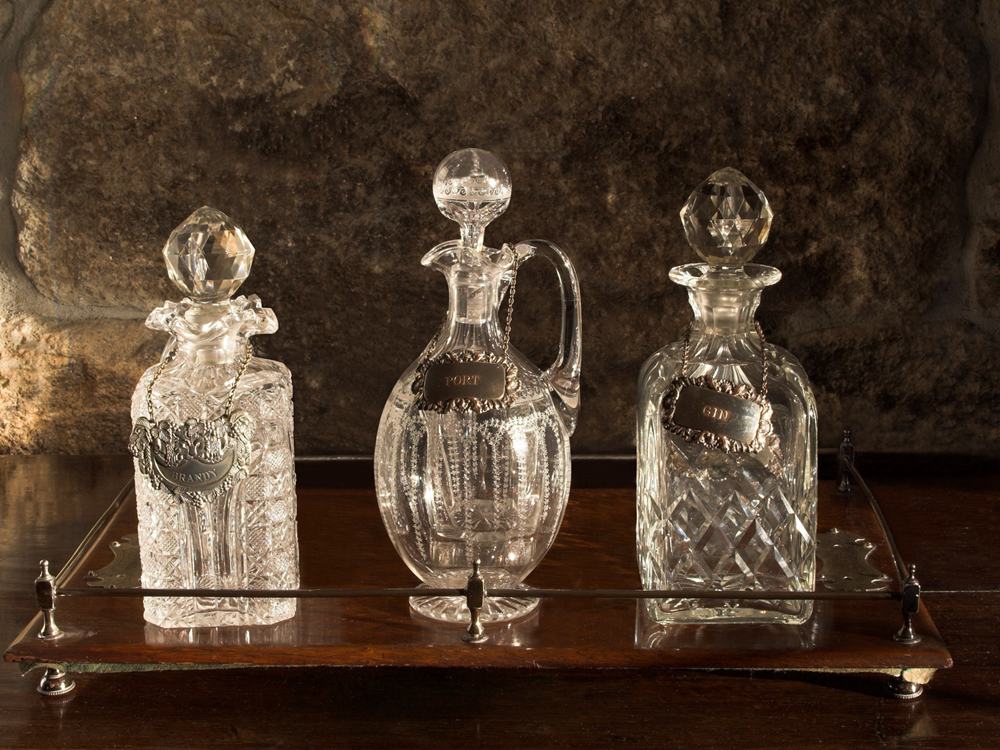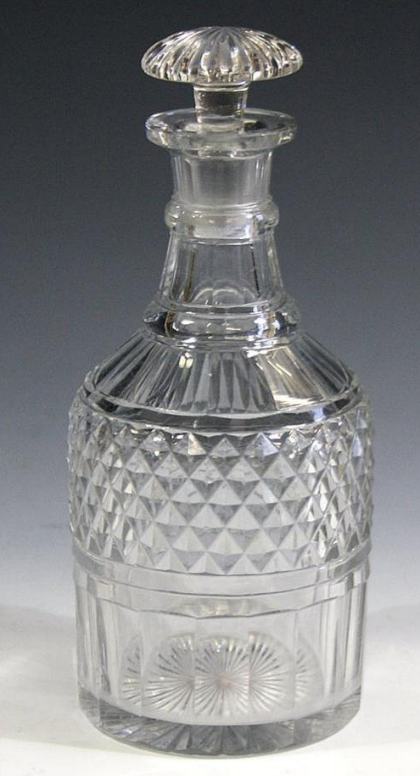Antique glass decanters offer a unique flair and sense of elegance to any home, and with a rich history and numerous styles to choose from, there’s something for every collector. Whether you’re a seasoned enthusiast or just beginning your journey into the world of antique glassware, this Identification and Value Guide is here to help you navigate the fascinating world of decanters. In this guide, we will discuss how to identify different styles of decanters, determine their value, and explore the factors that can influence their worth.
As you delve into the realm of antique decanters, you’ll come across various types such as chiseled sides decanters, grenade decanters, gin decanters, gently twisted decanters, square glass decanters, vodka decanters, and globe-shaped decanters. Each of these styles has its own unique features and history, which can impact their overall value. To assist you in your search, this guide will provide key insights into recognizing these styles and understanding the factors that can contribute to their value.
In order to accurately assess the value of an antique glass decanter, it’s crucial to consider factors such as condition, age, rarity, and maker. Decanters that were created by renowned glass companies like Baccarat, Lalique, Tiffany, Steuben, and Waterford are typically more valuable than those from lesser-known makers. With the aid of this guide, you’ll be well-equipped to hone your skills in identifying and valuing these exquisite pieces of glassware, ultimately enhancing your collection.
Table of Contents
History of Antique Glass Decanters
Around 2,500 years ago, decanters came into use for the first time. Prior to their invention, wine was served in earthenware vessels. The need for a more elegant and efficient way of serving wine led to the emergence of glass decanters. In the Middle Ages, these decanters were used primarily by wealthy individuals and royalty.
In the 17th century, decanters began to take on a more functional role in addition to their decorative appeal. They were used as vessels for serving wine drawn from a bottle or barrel, which made serving and cleaning up significantly easier. Designed to preserve alcohol and prevent it from falling flat, decanters were also instrumental in enhancing the flavors and aroma of the drink served in them.
During the late 18th and early 19th centuries, colored glass decanters emerged in shades of blue, green, and amethyst. Despite the popularity of colored glassware, clear glass remained prevalent so as to allow the contents of the decanter to be seen and studied.
Some of the renowned glass companies that contributed to the evolution of decanters included Baccarat, Lalique, Tiffany, Steuben, and Waterford. These companies played a pivotal role in the development of antique glass decanters alongside numerous other smaller manufacturers.
In the 1800s, glass decanters became more practical with features such as flutes, rings, and stoppers. Additional details, like brands, logos, and patent numbers, can be found on these decanters, making it easier to identify and track their origin. Notably, some decanters even had seals made of cork or jute to keep the wine from leaking.
When it comes to evaluating the value of antique glass decanters, factors such as the presence of any seals, manufacturer’s marks, and the overall design contribute significantly to their worth. For example, lead glass decanters (also referred to as cut crystal) with elaborate designs and long stems generally have higher value, ranging in price from a few hundred to a few thousand dollars.
In summary, the history of antique glass decanters spans over centuries, filled with an array of designs, styles, and innovations. As a collector or enthusiast, understanding this rich history and the various factors that contribute to the value of these decanters will help improve your knowledge and appreciation of these exquisite pieces.
9 Types of Antique Glass Decanters
Globe-Shaped
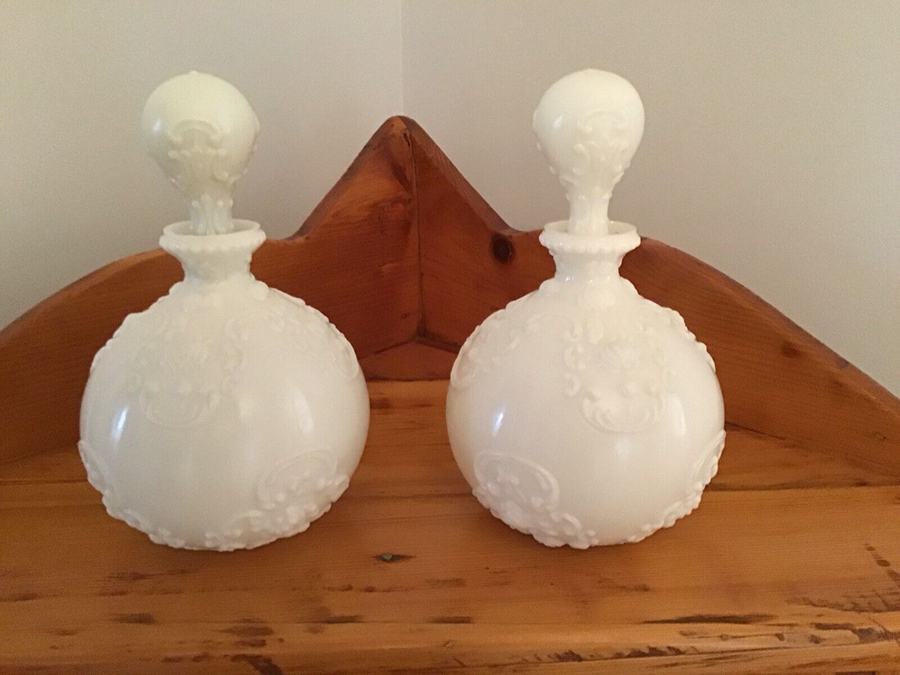
Globe-shaped decanters have a simple yet elegant design that features a round, convex body. They are typically made of glass or crystal, and their popularity originates from their balanced shape, which contributes to a stable and secure pouring experience.
Mallet
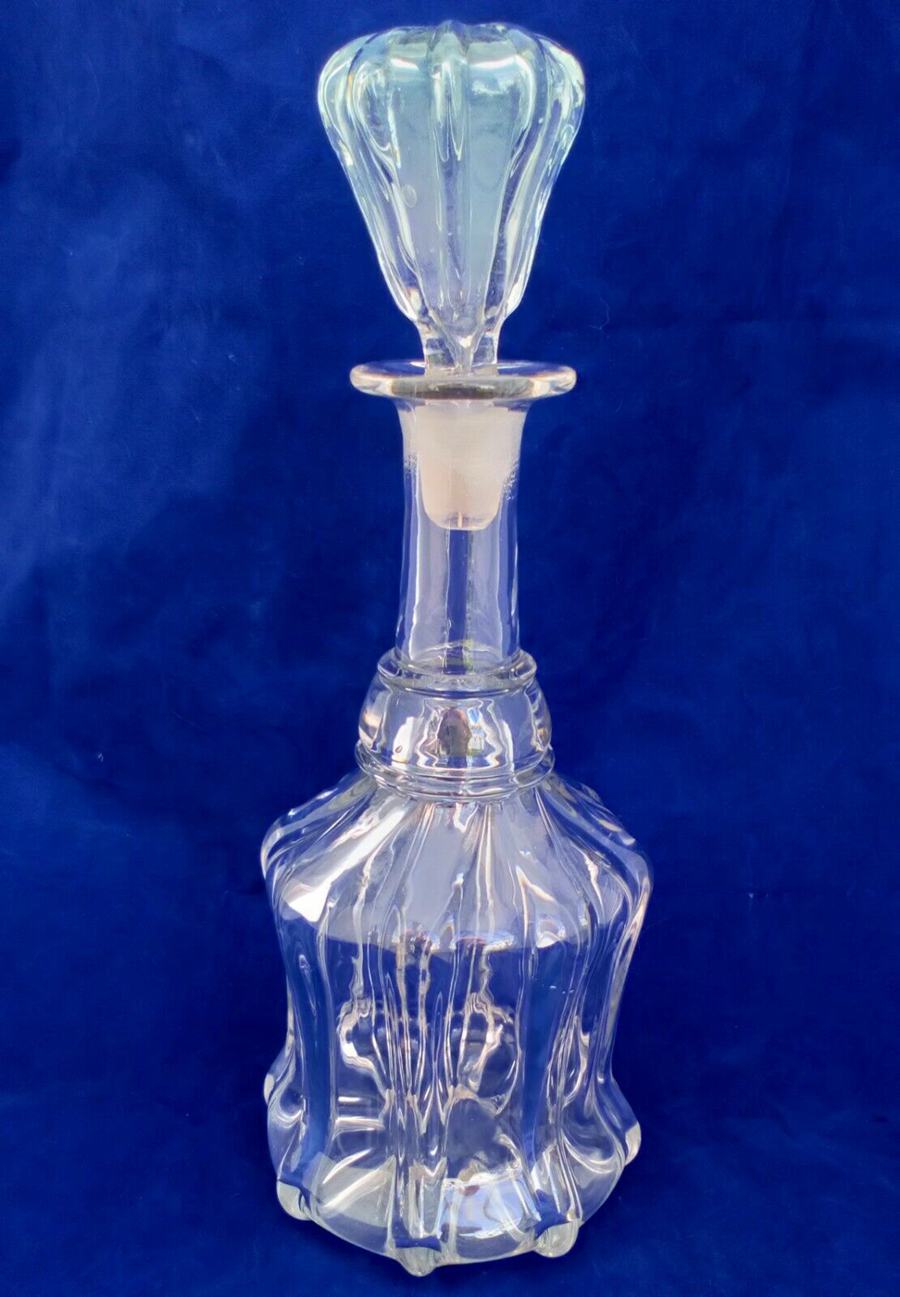
The mallet-shaped decanter is characterized by a cylindrical body that narrows towards the base, resembling a mallet. They were prevalent during the 18th century, particularly in England.
Cruciform
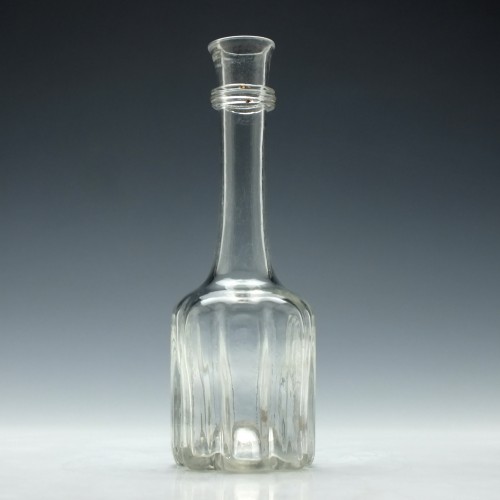
Cruciform decanters feature a unique design that resembles the shape of a cross. These decanters boast delicate craftsmanship, making them a popular collector’s item.
Amethyst
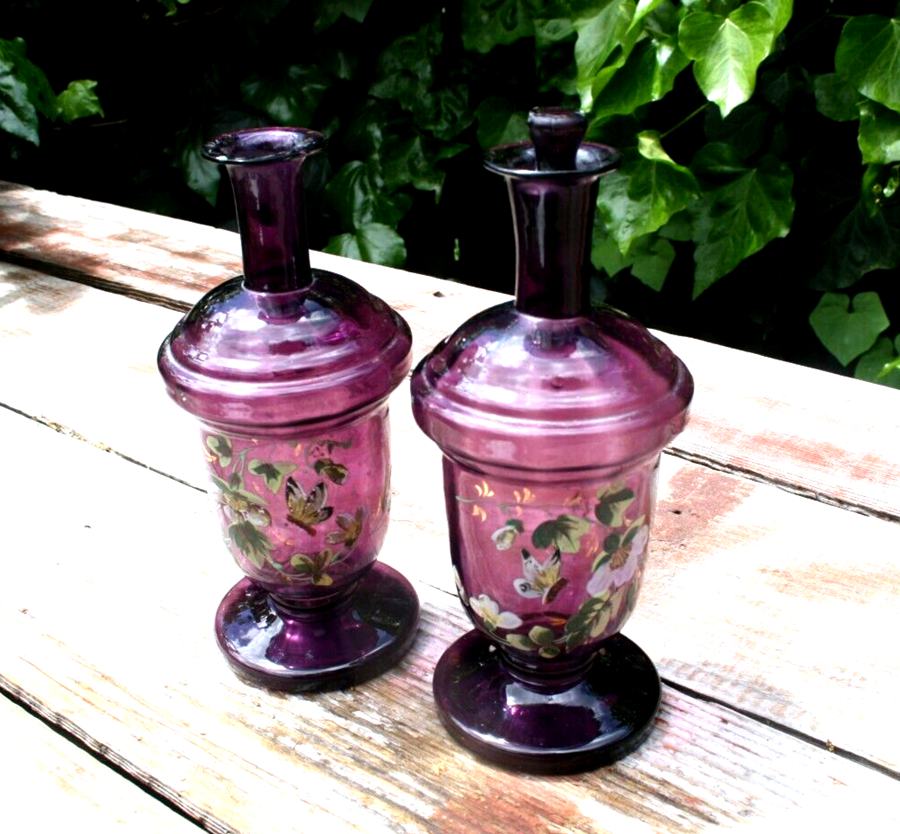
Amethyst decanters are made from amethyst glass, which is a beautiful deep purple color. These decanters are highly sought after for their striking appearance.
Claret
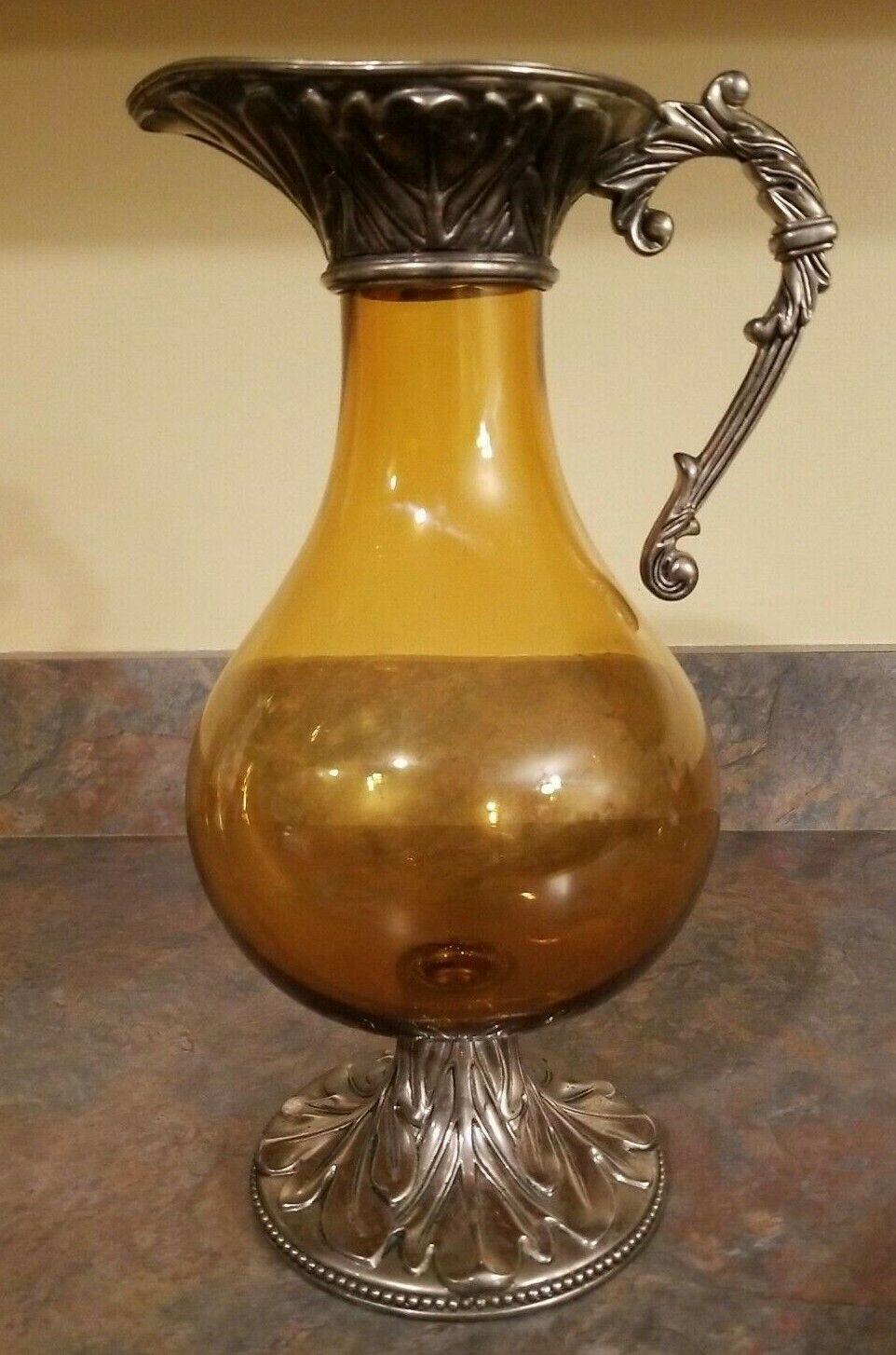
Claret decanters are specifically designed for decanting claret wines. They often have a slender and elegant shape, with a long neck for smooth pouring.
Grenade
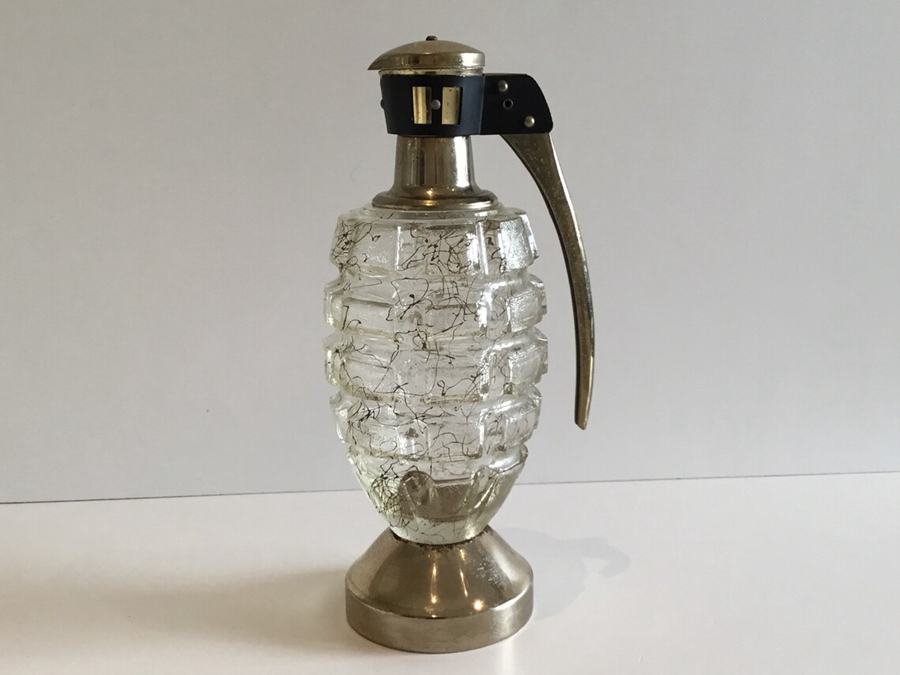
Grenade decanters are distinguished by their unique shape, which resembles a grenade.
Shaft and Globe Shape
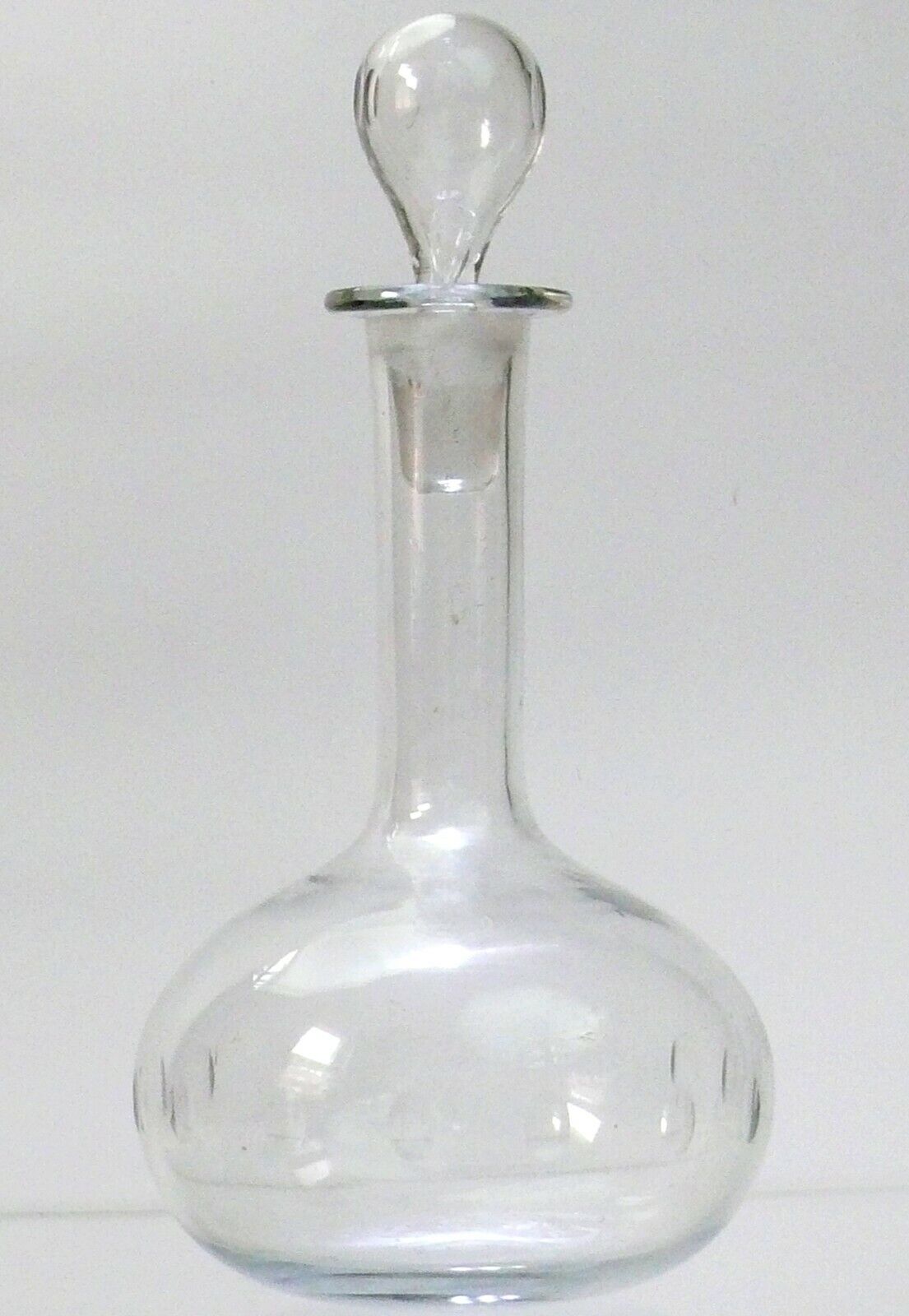
Shaft and globe decanters feature a round body with a long neck, creating an elegant appearance. These decanters were popular in the 18th century.
Shouldered
Shouldered decanters are characterized by their accentuated shoulders, which give the decanter a more prominent appearance.
Contemporary
Contemporary decanters are modern pieces that retain the essence of antique decanters while incorporating newer designs and materials. While their value may not be as high as some of the older, more classic types, contemporary decanters can still fetch a decent value if they are well-crafted and display excellent artistry.
When evaluating the value of antique decanters, remember that factors such as age, condition, and the manufacturer play significant roles in determining the final price.
Notable Antique Decanters and Brands
When identifying and valuing antique glass decanters, it’s essential to consider the notable brands, as well as the unique characteristics of each decanter type. By examining these attributes, you can determine the approximate value and rarity of your decanter.
Baccarat Crystal
Baccarat Crystal, a prestigious French manufacturer, is known for its exquisite craftsmanship and high-quality crystal decanters. Their beautifully designed decanters can range in value from $300 to $1,500, based on factors such as age, design, and condition.
Highland Park 50-Year-Old Decanter
Highland Park, a renowned Scotch whisky producer, released the 50-year-old decanter, which features a hand-blown glass design crafted by Brodie Nairn and Nicky Burns. This limited release dramatically increases in value, with approximate prices ranging from $15,000 to $20,000.
Irish Decanters: Waterford Crystal
Originating from Ireland, Waterford Crystal is a well-known brand for its intricate designs and exceptional quality. Antique Waterford decanters can fetch anywhere from $100 to $500, depending on the design and manufacturing period.
Lalique
Renowned for its unique Art Nouveau and Art Deco designs, Lalique’s antique glass decanters showcase stunning designs and impressive craftsmanship. The value of these decanters ranges between $500 and $2,000, depending on factors like rarity, design, and condition.
| Brand | Average Valuation Range |
|---|---|
| Baccarat | $300 – $1,500 |
| Highland Park | $15,000 – $20,000 |
| Waterford | $100 – $500 |
| Lalique | $500 – $2,000 |
Tiffany and Steuben
Both Tiffany and Steuben are highly sought-after antique glass decanter brands, with Tiffany known for its extraordinary designs and elegant styles, whereas Steuben is revered for its luxurious glass creations. Tiffany antique decanters can range from $500 to $2,000, while Steuben decanters might be valued between $400 and $1,500.
Remember to consider these notable brands when trying to identify and value your antique glass decanters. Keep in mind the unique attributes and manufacturing periods to get an accurate estimation of your decanter’s worth.
Factors to Identify & Value an Antique Glass Decanters
1. Age and History
Decanters have been a prominent part of history, with their use dating back about 2,500 years. Initially, wines were served in earthen vessels, as glass vessels had not yet been invented. The practice of decanting became increasingly popular in the 17th century, particularly in the United Kingdom, and eventually spread across Europe.
To identify old glass decanters from the 1700s, pay attention to their characteristics. Decanters from this period often resemble wide, long-necked flasks with flat bases, straight sides, and large bases. You may also find designs featuring leaves or flowers. These decanters will not have rims or seams.
In addition to the age, the value of antique glass decanters is impacted by factors such as the manufacturer, design, and condition. Notable glass manufacturers include Baccarat, Lalique, Tiffany, Steuben, and Waterford.
To help you estimate the value of your antique glass decanter, refer to the valuation table below:
| Factor Influencing Value | Average Valuation |
|---|---|
| Age (e.g., 1700s) | $500 – 600 |
| Manufacturer (e.g., Lalique) | $450 – 500 |
| Design (e.g., Floral Patterns) | $300 – 350 |
| Condition (e.g., Excellent) | $100 – 120 |
Keep in mind that the specific value of your decanter may vary depending on additional factors. One way to ensure accurate identification and valuation is to look for signatures or marks. Glass manufacturers typically sign or mark their pieces on the underside of the glass or on the body. If you have difficulty reading the signature, rubbing the area with a charcoal pencil can make it more visible.
By understanding the age, history, and factors affecting the value of antique glass decanters, you can be well-prepared to assess and appreciate the worth of these unique pieces.
2. Maker’s Mark or Signature
When identifying and valuing antique glass decanters, one key aspect to examine is the maker’s mark or signature. These marks can usually be found at the base of the decanter and hold crucial information about its origin and manufacturer. Knowing the maker will assist in determining the decanter’s value.
To locate the maker’s mark or signature on your antique glass decanter, follow these steps:
- Place the decanter on its side between two books so it won’t roll. It’s essential to ensure that the decanter is stable during inspection.
- Using a magnifying glass, carefully examine the base of the decanter for any markings or signatures. These can be engraved, etched, or embossed depending on the manufacturer.
- Pay special attention to the center and edges of the base. You can also use a loupe, a small magnifying glass used by experts, to scrutinize the flat surface of the bottom.
When determining the value of antique glass decanters, several factors affect their worth. Below is a table showcasing the valuation of decanters based on various factors:
| Decanter’s Factor | Average Valuation |
|---|---|
| European decanter (thin flutes, ribs) | $150 – 200 |
| French decanter (ornate, birds, vines) | $300 – 500 |
| Uniform Cube (4-straight sides) | $500 – 600 |
| Rounded Rectangle (one horn) | $450 – 500 |
| Rounded Rectangle (two horns) | $500 – 600 |
| Cylindrical (half-round) | $300 – 350 |
| Pyramid (triangular) | $100 – 120 |
| Tear Drop Shaped | $100 – 150 |
| Stepped Decanter | $70 – 80 |
Keep in mind that these valuations are estimates and may vary depending on factors such as the specific maker, condition, and rarity. Always consult with a qualified appraiser or expert to ensure you’re accurately assessing the value of your antique glass decanter.
3. Material and Quality
When identifying and valuing antique glass decanters, the material and quality play crucial roles. It’s important to recognize whether a decanter is made from standard glass or crystal, as well as determine the quality of craftsmanship involved in creating it.
Antique Glass Decanters Materials
Antique glass decanters typically come in two materials:
- Standard Glass: These decanters are made from a simple, pure-glass mixture without any additional components.
- Lead Glass (Crystal): These decanters contain a lead oxide mix, which makes the glass heavier and often more valuable than standard glass.
Furthermore, antique glass decanters should have no seam, as true antiques were not made using molds or joins. This absence of seams and a heavier weight often indicate that the decanter is a genuine antique piece.
Quality of Workmanship
The overall craftsmanship of antique glass decanters is essential when determining their value. Focus on the intricacy of the glass cutting, the presence of any engravings, and the condition of the decanter. Keep in mind that decanters in perfect condition generally fetch higher values than those with any form of damage.
| Antique Glass Decanters Feature | Average Valuation |
|---|---|
| Chiseled Sides | $200 – 300 |
| Grenade Decanter | $250 – 350 |
| Gin Decanter | $150 – 250 |
| Gently Twisted Decanter | $200 – 300 |
| Square Glass Decanter | $180 – 280 |
| Vodka Decanter | $190 – 290 |
| Globe-Shaped Decanter | $220 – 320 |
The above table provides an average valuation for different types of antique glass decanters based on the factors affecting their overall value. Keep in mind that these ranges are only estimates, and the actual worth of a specific decanter may vary depending on its condition, rarity, and the materials from which it is made.
4. Style and Design
When it comes to antique glass decanters, there are several distinct styles and designs that can help you identify their origins and potential value. Some common styles include chiseled sides, grenade-shaped, gin, gently twisted, square glass, vodka, and globe-shaped decanters. To give you an idea of how these different styles might affect their value, consider the following valuation table:
| Decanter Style | Average Valuation |
|---|---|
| Chiseled Sides | $200 – 300 |
| Grenade-Shaped | $250 – 350 |
| Gin | $150 – 200 |
| Gently Twisted | $300 – 400 |
| Square Glass | $200 – 250 |
| Vodka | $150 – 200 |
| Globe-Shaped | $350 – 450 |
Besides the style and design, certain factors can influence the value of an antique glass decanter, such as:
- Origin: European decanters, for example, tend to be less ornate than their French counterparts, which typically feature intricate designs with birds and vines. This difference in design can impact their value, with European decanters often being valued between $150 – 200, while French decanters can fetch $300 – 500.
- Weight and Material: Antique crystal decanters are heavier than glass ones due to the inclusion of lead in their construction. This weight difference, along with the crystal’s ability to create rainbows when held under light, can make crystal decanters more valuable than their glass counterparts.
- Condition: Naturally, decanters in better condition will be worth more than those with chips or cracks. Ensuring the stopper is still present is also crucial, as it plays a role in preserving the alcohol contained within.
By understanding the various styles and designs of antique glass decanters, as well as the factors that can affect their value, you will be better equipped to estimate the worth of your own antique decanters. Be sure to research specific styles, materials, and origins to further refine your estimations and appreciate the fine craftsmanship behind these timeless pieces.
5. Condition
When assessing the condition of antique glass decanters, it’s essential to carefully inspect the entire piece. In this section, you will learn about the various aspects that impact the value of your decanter based on its condition.
Visual Inspection
Start with a thorough visual inspection. Look for factors such as:
- Chips or cracks: These can significantly reduce the value of your antique decanter. If you notice any chips or cracks, factor this into your valuation.
- Clarity: Crystal decanters should be clear and polished, while glass decanters can exhibit some imperfections. If your crystal decanter has cloudiness or stains, it may be worth less than one in pristine condition.
- Maker’s marks or patterns: Examine the decanter closely for any etched markings or patterns, typically found on the side or bottom. These can provide valuable information about the manufacturer and sometimes influence the overall value.
Weight and Appearance
The weight and appearance of antique glass decanters often reveal whether they are made of crystal or glass. Crystal decanters infused with lead will be heavier than their glass counterparts. When held under a light, crystal decanters cast rainbows due to their prism effect. This appearance can impact the decanter’s value positively.
Valuation Table
Here is a table outlining the average valuation for antique glass decanters based on several factors related to their condition:
| Condition Factors | Average Valuation |
|---|---|
| Pristine, no chips or cracks, crystal, clear & polished | $450 – $600 |
| Glass, minimal imperfections, no chips or cracks | $300 – $450 |
| Crystal, cloudiness or staining, no chips or cracks | $250 – $400 |
| Glass, visible imperfections, no chips or cracks | $150 – $300 |
| Chips or cracks present, any material | $50 – $150 |
Keep in mind that these are just guidelines, and the actual value of your antique glass decanters could vary depending on additional factors such as rarity, age, and demand.
6. Rarity and Uniqueness
When examining the rarity and uniqueness of antique glass decanters, there are several factors to consider. These factors affect their value and help you identify the true treasures among your collection.
Decanters can be found in various shapes, colors, and materials. The list below displays some common types of antique decanters, with their respective average valuations:
| Antique Glass Decanter Type | Average Valuation |
|---|---|
| Cut Glass Decanter | $200 – $300 |
| Colored Glass Decanter | $100 – $200 |
| Etched Glass Decanter | $150 – $250 |
| Blown Glass Decanter | $50 – $150 |
Several key factors contribute to a decanter’s rarity and uniqueness:
- Age: Older decanters usually have higher value due to their rich history and scarcity.
- Manufacturer: Renowned manufacturers often produce high-quality decanters that are more valuable.
- Design: Unique, intricate designs and patterns can increase a decanter’s value significantly.
- Condition: Decanters in excellent condition with no damage or repairs fetch a higher value.
To identify antique glass decanters, you should:
- Examine the overall appearance: Look for any unique features, patterns, or colors that may indicate its age and rarity.
- Check for signatures or marks: Manufacturers often included their signatures or marks on the decanter, usually on the underside or body of the glass. If you have trouble reading signatures, try rubbing the glass with a charcoal pencil to reveal the signature more clearly.
- Research the manufacturer: Once you’ve identified the manufacturer, conduct further research to understand the decanter’s background and history, which could influence its value.
Remember that the actual value of a specific antique glass decanter can vary depending on the specific factors listed above. Consult with an experienced appraiser or conduct your own research to accurately determine the rarity and value of your antique glass decanter.
7. Provenance or Ownership History
Knowing the provenance or ownership history of an antique glass decanter can greatly affect its value. Provenance provides insight into the decanter’s origin, age, and authenticity, as well as its historical significance. Keep in mind the following factors when deciphering ownership history:
- Documentation: Original receipts, auction records, or letters detailing the decanter’s ownership history can significantly increase its value.
- Previous Owners: A prominent previous owner or a well-known collection can add to the desirability and value.
- Usage: Decanters with a unique use (e.g., ceremonial purposes, diplomatic gatherings, or historical events) may warrant higher values.
Valuation by Provenance Factors
| Provenance Factor | Average Valuation |
|---|---|
| Documented Ownership History | $600 – 700 |
| Prominent Previous Owners | $500 – 600 |
| Unique Usage | $400 – 500 |
| Unknown Provenance | $100 – 200 |
Remember, the value of an antique glass decanter can be further enhanced or diminished by the following factors:
- Condition: Decanters in perfect condition are worth more than those with damage, chips, or cracks.
- Age & Rarity: Older decanters, particularly those from the 1700s, have higher value due to their rarity.
- Manufacturer Marks: Look for etched patterns, symbols, or marks on the decanter that can be associated with specific manufacturers, as this can increase the value.
Pay careful attention to these factors while studying your antique glass decanter to get a better understanding of its provenance and value.
8. Demand and Market Trends
The global glass decanters market is growing, due to an increasing interest in antique glassware and a growing appreciation for handcrafted items. The market is expected to experience a Compound Annual Growth Rate (CAGR) of 3%, with an estimated valuation of US$ 427.73 Bn by 2032, up from US$ 318.27 Bn in 2022. North America currently holds the largest share of the glass decanters market.
When valuing antique glass decanters, several factors come into play, such as the decanter’s shape, age, design, and brand. Here, we provide a breakdown of the average valuations based on different factors:
Decanter Shape Valuation Table
| Antique Decanter’s Shape | Average Valuation |
|---|---|
| Uniform Cube, 4-straight sides | $500 – 600 |
| Rounded Rectangle with One Horn | $450 – 500 |
| Rounded Rectangle with Two Horns | $500 – 600 |
| Cylindrical, Half-Round | $300 – 350 |
| Pyramid, Triangular | $100 – 120 |
| Tear Drop Anvil | $100 – 150 |
| Stepped Anvil | $70 – 80 |
Keep in mind that these valuations are just average estimates and the value of your decanter may vary. The age of your glass decanter also plays a crucial role in determining its value, with older decanters generally being more precious. For instance, decanters from the 1700s are highly sought after due to their rarity and craftsmanship.
Additionally, the brand and designer of the decanter can significantly affect its value, with certain brands and designers commanding premium prices. If you have a decanter from a renowned brand or artist, it’s likely to be worth more than a similar piece from a less well-known source.
Lastly, market trends and fluctuations influence the value of antique decanters. Just like any collectible, the price might be volatile, depending on market demand. It’s essential to keep up-to-date with current market trends and consult price guides to ensure you have an accurate understanding of your decanter’s value.
9. Size and Dimensions
When identifying and valuing antique glass decanters, size and dimensions play a crucial role. Antique decanters come in various sizes, from small to large, and their dimensions can provide clues about their origin, age, and value. In this section, you’ll learn about different size categories and the valuation trends related to them.
Antique decanters are typically wider at the base and narrower at the top, with elongated stems. The dimensions of a decanter can vary depending on its shape, be it an organic, curved design, or a more rigid, geometric form. For example, European decanters tend to have thin flutes and a smaller stature, while French decanters are more ornate with intricate designs and more substantial dimensions.
Consider the following table outlining the valuation trends for different decanter dimensions:
| Decanter Size | Average Valuation |
|---|---|
| Small | $150 – 200 |
| Medium | $200 – 400 |
| Large | $300 – 500 |
| Extra Large | $500 – 1,000 |
Keep in mind that these valuations may not apply to all decanters, as factors such as age, condition, rarity, and craftsmanship can also influence a decanter’s value. However, the table above serves as a general guideline when assessing decanter dimensions and their potential worth.
As you encounter various antique glass decanters, take note of their dimensions and compare them against the size categories listed above. This will help you develop a better understanding of how these factors influence the overall value of a piece and give you a more accurate estimation when assessing decanters yourself. Remember that while size and dimensions are crucial, they are only one aspect of many when it comes to determining the value of an antique decanter.
10. Accessories and Stoppers
When examining antique glass decanters, you’ll find that accessories and stoppers play a significant role in identification and valuation. Stoppers are essential as they ensure the contents of the decanter are kept intact and fresh. Accessories, such as labels or tags, may help identify the decanter’s origin or maker.
Decanter Stoppers
There are various types of stoppers used in antique glass decanters. Some common types include:
- Ball stopper: A round, globe-shaped stopper often found in decanters from the early 19th century.
- Mushroom stopper: Resembling a mushroom’s shape, this stopper consists of a domed top and a thin stem.
- Faceted stopper: Found in cut-glass decanters, these stoppers have multiple facets and angles, often matching the decanter’s design.
Here’s a valuation table for decanters based on stopper type:
| Stopper Type | Average Valuation |
|---|---|
| Ball Stopper | $300 – 400 |
| Mushroom Stopper | $250 – 350 |
| Faceted Stopper | $200 – 300 |
Decanter Accessories
Accessories can help complete a decanter set or add value to a standalone piece. Common decanter accessories include:
- Drip rings: Small metal rings that fit around the decanter’s neck to catch any drips while pouring.
- Labels or tags: These may be metal or even engraved directly onto the decanter, indicating the type of liquid it contains (e.g., whiskey, brandy, wine).
- Coasters or trays: Sometimes made of silver or other decorative materials, to place underneath the decanter while on display.
Value for decanters with accessories can vary greatly depending on the quality, materials, and rarity of the accessories. It’s important to consider these factors when evaluating decanters with accompanying accessories:
| Accessory Type | Impact on Valuation |
|---|---|
| Drip Rings | Moderate |
| Labels/Tags | High |
| Coasters/Trays | Moderate to High |
By understanding the different types of stoppers and accessories associated with antique glass decanters, you can better assess their value and make more informed decisions when buying or selling these collectible items.
Final Thoughts
When it comes to antique glass decanters, properly identifying and understanding their value is essential. As you explore the world of decanters, remember to consider factors such as the manufacturer, design, and material to determine their worth.
Pay attention to specific details like etched marks or patterns, as these may provide you with essential information regarding the decanter’s origin. It is essential to do thorough research on manufacturers, historical periods, and design factors to gain a comprehensive understanding of the decanter’s value.
In your quest to identify valuable antique glass decanters, you may come across exquisite designs from renowned manufacturers like Waterford, St. Louis, Baccarat, and Orrefors. These high-end decanters can range in value from $25,000 to $3.5M.
As you continue your journey, it is crucial to:
- Study antique glass decanters’ history and evolution over time to establish an understanding of their value and rarity.
- Consult reputable resources and expert advice to validate your findings.
- Develop your eye for quality and craftsmanship, as these factors directly impact the decanter’s value.
- Preserve and maintain the condition of your antique glass decanters, as proper care will significantly affect their market value.
By following these guidelines and the information contained within this guide, you are well-equipped to navigate the fascinating world of antique glass decanters. Good luck with your endeavors, and may your collection continue to grow and flourish.
FAQ
What are the different types of antique glass decanters?
There are various types of antique glass decanters that you can identify and collect. Some popular types include:
- Chiseled Sides Decanter
- Grenade Decanter
- Gin Decanter
- Gently Twisted Decanter
- Square Glass Decanter
- Vodka Decanter
- Globe-Shaped Decanter
Each of these decanters has its unique features and characteristics that can help you identify them.
How can I determine the value of an antique glass decanter?
To determine the value of an antique glass decanter, consider the following factors:
- Age: Older decanters are typically considered more valuable.
- Condition: Decanters in good condition with no cracks or chips are more valuable.
- Rarity: Decanters that are rare or hard to find may be worth more.
- Maker: Decanters made by renowned glass companies like Baccarat, Lalique, Tiffany, Steuben, and Waterford are typically more valuable.
You may also reference antique decanter guides or consult with an expert to get a better idea of the value of a specific piece.
What are decanters used for?
Historically, decanters have been used for storing and serving various types of alcohol, such as wine, whiskey, gin, and vodka. They were especially popular in the late 18th and early 19th centuries. Today, they are often used as decorative pieces to showcase their beautiful designs.
Can the color of the glass affect the value of a decanter?
Yes, the color of a decanter’s glass can affect its value. Colored glass decanters were popular in the late 18th and early 19th centuries, with shades of blue, green, and amethyst being particularly sought after. Clear glass decanters were also common, but colored glass pieces may be more valuable due to their visual appeal.

